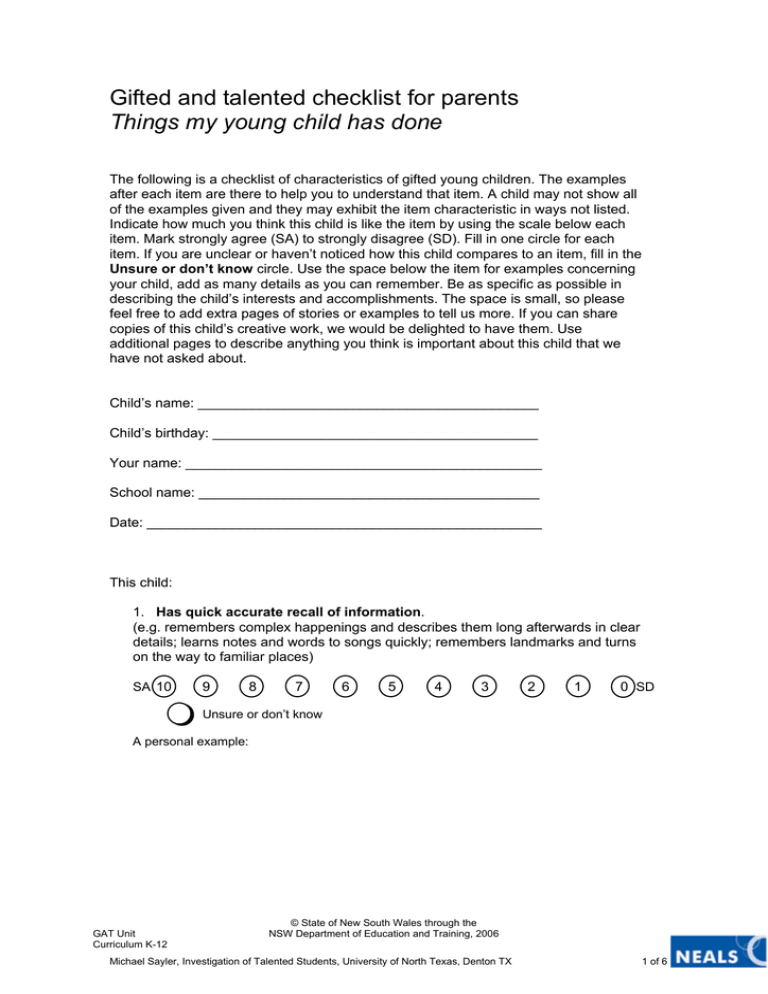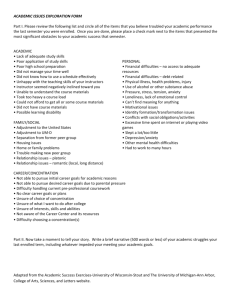Things my young child has done
advertisement

Gifted and talented checklist for parents Things my young child has done The following is a checklist of characteristics of gifted young children. The examples after each item are there to help you to understand that item. A child may not show all of the examples given and they may exhibit the item characteristic in ways not listed. Indicate how much you think this child is like the item by using the scale below each item. Mark strongly agree (SA) to strongly disagree (SD). Fill in one circle for each item. If you are unclear or haven’t noticed how this child compares to an item, fill in the Unsure or don’t know circle. Use the space below the item for examples concerning your child, add as many details as you can remember. Be as specific as possible in describing the child’s interests and accomplishments. The space is small, so please feel free to add extra pages of stories or examples to tell us more. If you can share copies of this child’s creative work, we would be delighted to have them. Use additional pages to describe anything you think is important about this child that we have not asked about. Child’s name: ____________________________________________ Child’s birthday: __________________________________________ Your name: ______________________________________________ School name: ____________________________________________ Date: ___________________________________________________ This child: 1. Has quick accurate recall of information. (e.g. remembers complex happenings and describes them long afterwards in clear details; learns notes and words to songs quickly; remembers landmarks and turns on the way to familiar places) SA 10 9 8 7 6 5 4 3 2 1 0 SD Unsure or don’t know A personal example: GAT Unit Curriculum K-12 © State of New South Wales through the NSW Department of Education and Training, 2006 Michael Sayler, Investigation of Talented Students, University of North Texas, Denton TX 1 of 6 2. Shows intense curiosity and deeper knowledge than other children. (e.g. insatiable need to know and explore; later on he or she collects things and then learns all he or she can about them; remembers things in great detail. SA 10 9 8 7 6 5 4 3 2 1 0 SD Unsure or don’t know A personal example: 3. Is empathetic, feels more deeply than do other children that age. (e.g. feels unusual hurt or pain when he or she displeases someone; shows pride in advanced accomplishments; is sensitive to others’ feelings and shows distress at other children’s distress or adult’s distress; will subjugate their needs to the needs of others; reads body language) SA 10 9 8 7 6 5 4 3 2 1 0 SD Unsure or don’t know A personal example: 4. Use advanced vocabulary. (e.g. correctly uses vocabulary adults would expect from older children; surprises adults and children with big words they use; knows more words than other children; stops to ask about new words then remembers them and uses them correctly later) SA 10 9 8 7 6 5 4 3 2 1 0 SD Unsure or don’t know A personal example: GAT Unit Curriculum K-12 © State of New South Wales through the NSW Department of Education and Training, 2006 Michael Sayler, Investigation of Talented Students, University of North Texas, Denton TX 2 of 6 5. Began to read, write or use numbers early. (e.g. early interest in the alphabet and or numbers; liked to imitate writing as a toddler; copied letters, words or numbers; learned to read or count early without formal instruction; developed computational skills earlier than others) SA 10 9 8 7 6 5 4 3 2 1 0 SD Unsure or don’t know A personal example and approximate age of your child at the time: 6. Understood phrases or brief sentences as an infant. (e.g. listened intently; understood and acted on short sentences such as ‘Give mum a hug’ or ‘Bring me the book and I will read to you’) SA 10 9 8 7 6 5 4 3 2 1 0 SD Unsure or don’t know A personal example and approximate age of your child at the time: 7. Began speaking first in words and sentences earlier than other children. (e.g. spoke first words before age one; went from saying individual words to speaking sentences quickly or, spoke first words later than age one and quickly moved to speaking in complete sentences; carried on conversations with adults as if they were peers) SA 10 9 8 7 6 5 4 3 2 1 0 SD Unsure or don’t know A personal example and approximate age of your child at the time: GAT Unit Curriculum K-12 © State of New South Wales through the NSW Department of Education and Training, 2006 Michael Sayler, Investigation of Talented Students, University of North Texas, Denton TX 3 of 6 8. Early motor development. (e.g. very visually attentive during the first six months, watched people carefully; followed movement intently; walked early; fed himself or herself sooner than other children; active use of toys and puzzles) SA 10 9 8 7 6 5 4 3 2 1 0 SD Unsure or don’t know A personal example and approximate age of your child at the time: 9. Shows unusually intense interest and enjoyment when learning new things. (e.g. listens for long periods of time to stories and conversations; retells events and stories in great detail; entertains self for long periods of time; shows unwavering attention sometimes to the point of stubbornness; sits patiently when reading or listening to books) SA 10 9 8 7 6 5 4 3 2 1 0 SD Unsure or don’t know A personal example: 10. Has an advanced sense of humour or sees incongruities as funny. (e.g. is humorous in speech, social interactions, art or story telling; makes jokes, puns, plays on words) SA 10 9 8 7 6 5 4 3 2 1 0 SD Unsure or don’t know A personal example: GAT Unit Curriculum K-12 © State of New South Wales through the NSW Department of Education and Training, 2006 Michael Sayler, Investigation of Talented Students, University of North Texas, Denton TX 4 of 6 11. Understands things well enough to teach others. (e.g. likes to play school with other children, dolls or stuffed animals; talks like an ‘expert’ or likes to discuss certain topics a lot; explains ideas to adults; when he or she doesn’t think the adult understands very well) SA 10 9 8 7 6 5 4 3 2 1 0 SD Unsure or don’t know A personal example: 12. Is comfortable around older children and adults. (e.g. craves for attention from adults; likes to be with older children and adults; listens to or joins in adult conversations; likes to play board games designed for older children, teens or adults; often plays with and is accepted by older children) SA 10 9 8 7 6 5 4 3 2 1 0 SD Unsure or don’t know A personal example: 13. Shows leadership abilities. (e.g. sought out by other children for play ideas; adapts his or her own words and expectations to needs or skill level of playmates; may be seen as bossy; uses verbal skills to deal with conflicts or to influence other children) SA 10 9 8 7 6 5 4 3 2 1 0 SD Unsure or don’t know A personal example: GAT Unit Curriculum K-12 © State of New South Wales through the NSW Department of Education and Training, 2006 Michael Sayler, Investigation of Talented Students, University of North Texas, Denton TX 5 of 6 14. Is resourceful and improvises well. (e.g. finds unique or non-traditional ways; plays for long periods of time with imaginary friends; diligent in getting things they want regardless of where you’ve put them; makes up believable endings to stories) SA 10 9 8 7 6 5 4 3 2 1 0 SD Unsure or don’t know A personal example: 15. Uses imaginative methods to accomplish tasks. (e.g. presents unique arguments in order to convince others to allow him or her to do or get things; finds imaginative ways to get out of doing things they don’t want to do; curious with a high energy level that is goal directed) SA 10 9 8 7 6 5 4 3 2 1 0 SD Unsure or don’t know A personal example: 16. Use the rest of this page or its back to tell us anything you think is important about your child that we have not asked about. Please feel free to add information you think might be useful in giving us a clear picture of what your child has done. Be as specific as possible in describing your child’s interests and accomplishments. If you can share some copies of your child’s creative work, we would be delighted to have them. GAT Unit Curriculum K-12 © State of New South Wales through the NSW Department of Education and Training, 2006 Michael Sayler, Investigation of Talented Students, University of North Texas, Denton TX 6 of 6
